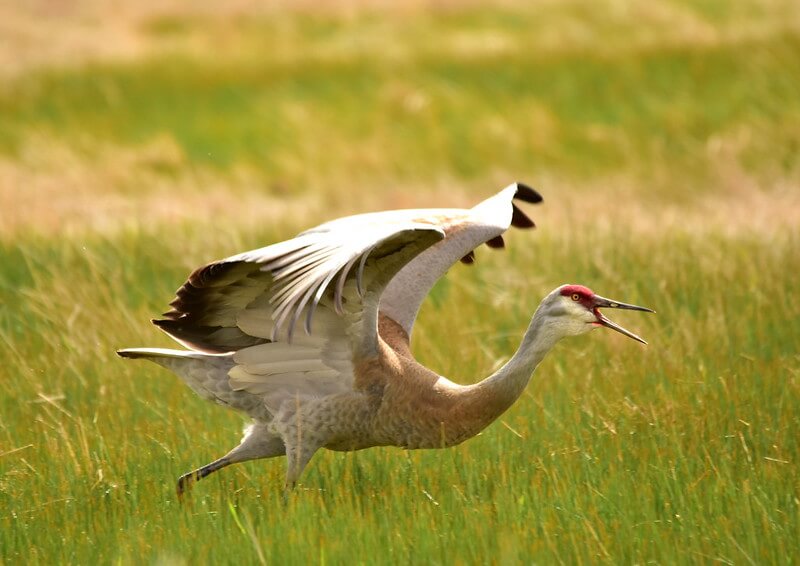Sandhill Cranes and the “Orchestra of Evolution”
by Drew Lefebvre
Broadcast 4.13 & 4.16.2022

Photo by Tom Koerner, USFWS, public domain.
Listen:
I’ll never forget the first time I heard the call of a Sandhill Crane. It was early June, and I was halfway through an eight-day backpacking trip in the Sapphire Mountains. Sitting in a meadow one evening and refilling my bottle at the oxbow of a quiet creek, I began to hear a sound unlike anything I’d ever heard. It was part elephant, part jackhammer, and part squeaky door hinge. One thing seemed clear: no way had that sound been made by a modern animal, and certainly not by a bird.
Returning to camp, the questioning look on my face must have given me away, because I was immediately told that the rattling noise I’d heard belonged to a Sandhill Crane. I borrowed a pair of binoculars and sure enough, there across the meadow were two giant, rusty-gray birds, lifting their wings as they danced and vocalized, the deep red of their foreheads just barely visible in the darkening summer evening. I couldn’t help thinking of dinosaurs.
It was an amazing sight. But to tell the truth, I was taking in amazing sights by the hundreds that summer. New to Montana and new to the world of backcountry trail work, every day brought untold sights, sounds, and experiences as I explored the wild lands of the northern Rocky Mountains. It wasn’t until the end of the season, when I finally had time to rest and reflect, that I remembered that evening in the Sapphires. The more I thought about it, the more surreal it felt. Had I dreamed the whole thing? Who were these creatures who descended raucously into quiet places, lifted their wings, and nearly shook the earth with their prehistoric cries?
It was easy to find out more about this magnificent species, because plenty of others before me have been fascinated as well. What’s more, I wasn’t alone in my thoughts of dinosaurs. When we hear a Sandhill Crane, “we hear no mere bird,” wrote conservationist Aldo Leopold. “We hear the trumpet in the orchestra of evolution…the symbol of our untamable past.”
These are more than just graceful words; Sandhills have the fossil record to back them up. Sandhill Cranes are, in fact, the oldest living bird species on the planet. Fossils from other species of Gruiformes—the taxonomic order to which cranes belong—date back about 60 million years, to a time shortly after the mass extinction that wiped out most dinosaurs. The oldest known definitive Sandhill Crane fossil, unearthed in coastal Florida, dates to about 2.5 million years ago. For reference, most modern birds can trace their lineage back about 1.8 million years. That’s still an unfathomably long time, of course, but Sandhills have a pretty decisive head start.
And there’s an even more impressive piece to this ancient puzzle: the discovery of a ten-million-year-old crane fossil in northeastern Nebraska. Now, this ancient relic—a wing fossil, to be precise—may not actually belong to a Sandhill Crane. It may be from an ancient, very closely related ancestor, known as the Crowned Crane. But the physical similarities to modern-day Sandhills are indisputable. What’s more, this ten-million-year-old artifact was uncovered near the Platte River, right smack in the middle of modern Sandhill Cranes’ migration routes. These ancient birds have been following the flight routes of their ancestors for millions and millions of years.
It’s a special feeling to bear modern witness to a species that has rightly been called a living fossil. Cranes’ seasonal patterns of migration, courtship, and yes, that indescribable bugling, are threads that bind us to “our untamable past.” I invite you to join me every spring in waiting for their yearly return. Let’s turn our ears skyward, our eyes inward, and listen for the dinosaurs.
Every week since 1991, Field Notes has inquired about Montana’s natural history. Field Notes are written by naturalists, students, and listeners about the puzzle-tree bark, eagle talons, woolly aphids, and giant puffballs of Western, Central and Southwestern Montana and aired weekly on Montana Public Radio.
Click here to read and listen to more Field Notes. Field Notes is available as a podcast! Subscribe on iTunes, Google Play, or wherever you listen to podcasts.
Interested in writing a Field Note? Contact Allison De Jong, Field Notes editor, at adejong [at] montananaturalist [dot] org or 406.327.0405.
Want to learn more about our programs as well as fun natural history facts and seasonal phenology? Sign up for our e-newsletter! You can also become a member and get discounts on our programs as well as free reciprocal admission to 300+ science centers in North America!












